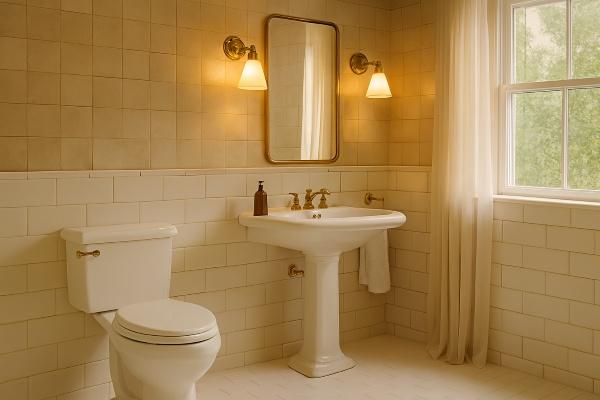Zellige tiles are handmade Moroccan clay tiles with irregular, glossy finishes and vibrant colors, while subway tiles are machine-made rectangular ceramic tiles with uniform, flat surfaces. The main difference lies in their craftsmanship, texture, and aesthetic: zellige offers artisan character and organic variations, whereas subway tiles provide clean, consistent lines perfect for modern and traditional spaces.
Choosing between zellige and subway tiles can transform your space from ordinary to extraordinary. Whether you're renovating a bathroom, upgrading your kitchen backsplash, or reimagining any interior surface, understanding the distinct characteristics of zellige versus subway tiles will help you make the right decision for your project. Both tile styles have captivated homeowners and designers, but they serve different aesthetic and practical purposes that deserve careful consideration.
What Are Zellige Tiles?
Zellige (also spelled zellij) tiles are traditional Moroccan tiles with a history spanning over a thousand years. These artisan tiles are handcrafted from natural clay, hand-cut, and glazed with vibrant, glossy finishes that create depth and luminosity.
The manufacturing process makes each zellige tile unique. Artisans shape the clay by hand, fire it in traditional kilns, and apply glazes that react differently during the firing process. This creates subtle variations in color, thickness, and surface texture that give zellige its signature organic, imperfect beauty.
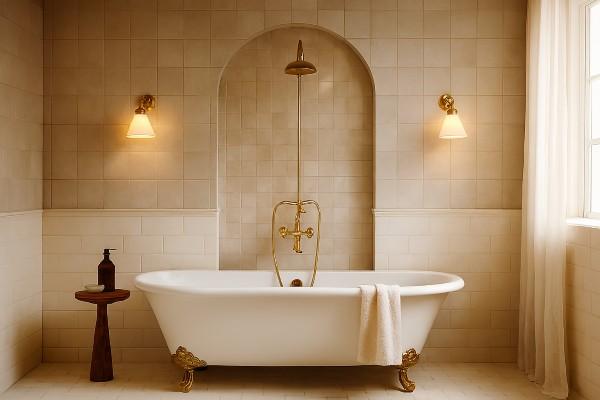
Characteristics of Zellige Tiles
Zellige tiles stand out for several distinctive features:
- Handcrafted authenticity: Each tile shows slight variations in size, shape, and color
- Glossy, reflective finish: The glaze creates depth and catches light beautifully
- Rich color palette: From deep jewel tones to soft pastels and earthy neutrals
- Irregular edges: Slightly uneven borders add to the artisanal charm
- Textured surface: Subtle undulations create visual and tactile interest
- Heritage craftsmanship: Tiles made using centuries-old Moroccan techniques
When you browse through tiles by style, you'll notice how zellige brings a distinctive Mediterranean and artisan aesthetic that's become increasingly popular in contemporary design.
What Are Subway Tiles?
Subway tiles earned their name from the iconic New York City subway stations where they first appeared in the early 1900s. These rectangular tiles feature a classic 3x6-inch dimension (though other sizes exist) with a simple, beveled edge and glossy finish.
Unlike zellige, subway tiles are typically machine-made, ensuring uniformity and precision. This manufacturing process creates tiles with consistent dimensions, flat surfaces, and predictable coloring that makes installation straightforward and reliable.
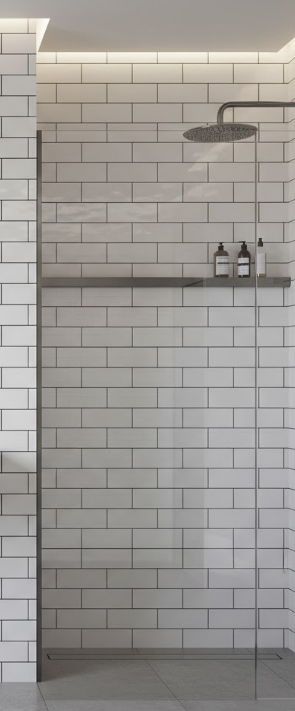
Characteristics of Subway Tiles
Subway tiles offer dependable features that have made them a design staple:
- Uniform dimensions: Consistent sizing ensures predictable installation
- Flat, smooth surface: Easy to clean and maintain
- Beveled edges: Create subtle shadow lines between tiles
- Versatile colors: Available in classic white plus numerous color options
- Affordable pricing: Mass production keeps costs accessible
- Timeless appeal: Works with both traditional and modern design schemes
At Nova Tile and Stone, we carry an extensive selection of both tile types, allowing you to compare options in person and choose the perfect fit for your project.
Key Differences Between Zellige and Subway Tiles
Understanding what sets these tiles apart helps you align your choice with your design vision and practical needs.
Manufacturing Process
Zellige tiles are entirely handmade by skilled artisans using traditional methods passed down through generations. This labor-intensive process creates organic variations that contribute to their unique character. Subway tiles are machine-manufactured in controlled factory settings, producing identical tiles with precision and efficiency.
Visual Appearance
The most striking difference appears in surface texture and finish. Zellige tiles have an undulating, slightly irregular surface with a deep, glossy glaze that creates dimension and visual interest. The variations in thickness and glazing produce tiles that shimmer and change appearance depending on lighting conditions.
Subway tiles present a flat, uniform surface with consistent coloring and a predictable finish. While some artisan-made versions exist, standard subway tiles maintain the clean, regular appearance that defines the style.
Installation Complexity
Installing zellige tiles requires more skill and patience. The irregular edges and varying thicknesses demand careful attention during layout and grouting. Many installers recommend wider grout lines (1/8 inch or more) to accommodate size variations and embrace the handmade aesthetic. For professional installation guidance, check out resources like this tile installation guide.
Subway tiles install more straightforwardly with tight, consistent grout lines and predictable spacing. The uniform dimensions make DIY installation more feasible for experienced homeowners.
Cost Considerations
Zellige tiles command premium pricing due to their handcrafted nature, typically ranging from $15 to $40 per square foot or more, depending on quality and source. Subway tiles offer budget-friendly options, usually costing between $1 to $15 per square foot.
Tile selection significantly impacts your overall renovation budget, making it essential to balance aesthetics with financial constraints.
Comparison Table: Zellige vs. Subway Tiles
Manufacturing | Handmade by artisans | Machine-made |
Surface Texture | Irregular, undulating | Flat, uniform |
Size Consistency | Slight variations | Perfectly consistent |
Color Variation | High (within same batch) | Minimal to none |
Finish | Deep, glossy, reflective | Glossy or matte options |
Price Range | $15-$40+ per sq ft | $1-$15 per sq ft |
Installation Difficulty | Advanced (professional recommended) | Moderate (DIY-friendly) |
Grout Line Width | Wider (1/8"+ recommended) | Narrow to moderate |
Design Style | Mediterranean, bohemian, eclectic | Classic, modern, transitional |
Maintenance | Moderate (textured surface) | Easy (smooth surface) |
Durability | High (properly installed) | High |
Availability | Limited, specialty suppliers | Widely available |
When exploring tiles by type, you'll discover how these characteristics translate into real-world applications and help narrow your selection.
Pros and Cons of Zellige Tiles
Pros
Distinctive Artisan Character: Every installation becomes a unique work of art. The handmade variations ensure no two projects look identical, creating spaces with genuine personality and authenticity.
Stunning Visual Depth: The glossy glaze and irregular surface create mesmerizing light play that changes throughout the day. This dimensional quality adds sophistication and luxury that flat tiles cannot replicate.
Rich Color Options: Zellige tiles come in stunning color palettes ranging from vibrant jewel tones to soft, muted hues. The glazing process produces colors with remarkable depth and complexity.
Heritage and Story: Choosing zellige connects your space to centuries of Moroccan craftsmanship. This cultural significance adds meaning and conversation value to your design.
Trending Appeal: Zellige has become highly sought-after in contemporary design, featured prominently in design magazines and popular renovation shows. This trend shows no signs of fading as homeowners seek authentic, artisanal elements.
Cons
Higher Cost: The premium price reflects the labor-intensive handmade process. Budget-conscious projects may find zellige financially challenging, especially for large areas.
Installation Complexity: Finding experienced installers familiar with zellige can be difficult. The irregular nature requires expertise to achieve beautiful results, and improper installation can compromise the final appearance.
Inconsistency Concerns: While variations create charm, some homeowners prefer uniformity. The unpredictable color and size variations may not suit those seeking precise control over their design outcome.
Limited Availability: Zellige tiles often require special ordering and longer lead times. Local availability can be restricted, making it harder to view samples in person before committing.
Maintenance Considerations: The textured surface can trap dirt and grime more easily than flat tiles. Regular cleaning maintains their beauty, but the irregular glaze may show wear patterns over time in high-traffic areas.
Pros and Cons of Subway Tiles
Pros
Timeless Versatility: Subway tiles have proven their staying power for over a century. They seamlessly integrate into virtually any design style, from vintage to ultra-modern, ensuring your investment won't look dated.
Budget-Friendly: Affordability makes subway tiles accessible for projects of any scale. You can achieve high-end looks without breaking the bank, leaving room in your budget for other upgrades.
Easy Installation and Maintenance: The uniform dimensions simplify installation, reducing labor costs. The smooth surface wipes clean effortlessly, making maintenance a breeze. According to bathroom flooring experts, ease of maintenance should factor heavily into tile selection.
Wide Availability: Subway tiles are stocked at virtually every tile retailer and home improvement store. This accessibility means you can view, purchase, and install them quickly without lengthy wait times.
Consistent Results: When you want predictable outcomes, subway tiles deliver. The uniformity ensures your finished project looks exactly as planned without surprises.
Pattern Flexibility: Despite their simple shape, subway tiles create numerous patterns. Try running bond (traditional brick pattern), vertical stack, herringbone, or basketweave layouts to customize your look.
Cons
Common Aesthetic: The popularity of subway tiles means they appear everywhere. Achieving a unique look requires creative patterns, colors, or grout choices to differentiate your space.
Less Visual Interest: The flat, uniform surface lacks the dimensional quality of artisan tiles. While clean and classic, subway tiles may feel plain to those seeking more textured, complex surfaces.
Grout Line Visibility: With tight grout lines, any installation imperfections become noticeable. Subway tiles require precision to look polished, and slight deviations stand out more than with irregular tiles.
Trend Saturation: Some designers argue subway tiles have become overused, particularly in white. While timeless, they may not offer the fresh, distinctive look that trendier options provide.
Which Tile Should You Choose?
Selecting between zellige and subway tiles depends on several key factors specific to your project and preferences.
Choose Zellige Tiles If:
Your design vision embraces character and individuality. Zellige shines when you want to create a statement feature wall, a showstopping backsplash, or a bathroom that feels like a luxurious retreat. These tiles excel in:
- Kitchen backsplashes where they become the focal point
- Bathroom shower surrounds for spa-like ambiance
- Accent walls that demand attention
- Smaller spaces where you can afford the premium pricing
- Projects where authenticity and craftsmanship matter most
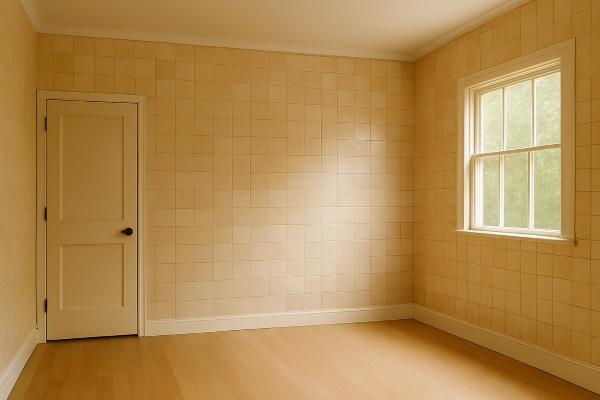
You should also choose zellige if you appreciate imperfection as beauty. The irregular nature requires acceptance that your tiles won't align perfectly, and that's precisely what makes them special. Browse ceramic tile design inspiration to see how artisan tiles transform spaces.
Choose Subway Tiles If:
Your priorities center on practicality, versatility, and budget consciousness. Subway tiles work beautifully for:
- Large wall areas where costs need to stay reasonable
- Full bathroom surrounds requiring extensive coverage
- Kitchen backsplashes throughout entire kitchens
- Shower enclosures in multiple bathrooms
- Commercial applications requiring durability and easy maintenance
- DIY projects where installation ease matters
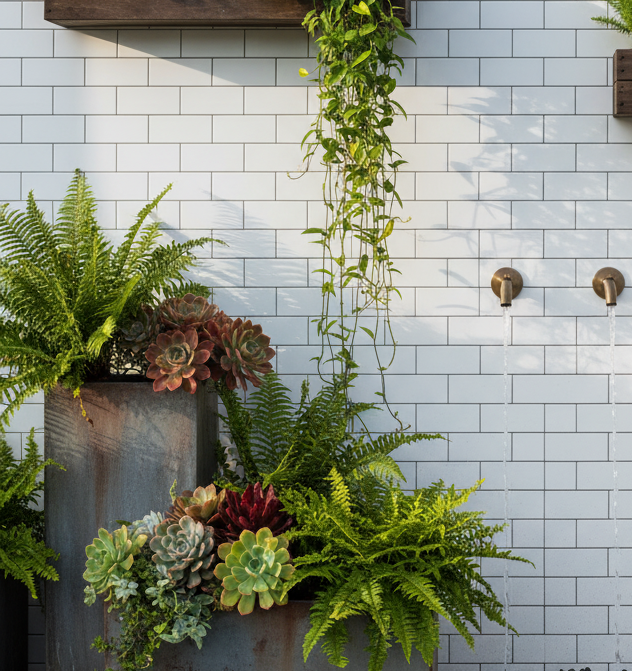
Subway tiles also suit homeowners who prefer clean, predictable results. If you want to control exactly how your finished project looks without surprises, subway tiles deliver that consistency. Explore bathroom remodel ideas to see how subway tiles adapt to various design schemes.
Consider Combining Both
Creative designers often blend these tile types for the best of both worlds. Consider using zellige as a feature element (perhaps behind a range or in a shower niche) while surrounding it with more affordable subway tiles. This approach delivers visual impact where it counts while managing costs strategically.
When visiting our showroom, you can see both tile types in person, compare them side by side, and envision how they'll work in your specific space.
Step-by-Step Guide to Choosing Between Zellige and Subway Tiles
Follow this practical process to confidently select the right tile for your project.
Step 1: Define Your Budget and Project Scope
Calculate your total square footage and establish a realistic tile budget. Remember to factor in installation costs, which run higher for zellige. If your budget allows $2,000 for materials and you need 100 square feet, you can afford $20 per square foot. This calculation immediately clarifies whether zellige fits your financial parameters or if subway tiles make more sense.
Don't forget to budget for additional materials: grout, adhesive, trim pieces like bullnose tiles, and waterproofing materials for wet areas.
Step 2: Assess Your Design Style and Vision
Examine your existing space and planned aesthetic. Collect inspiration images that resonate with you. If your design leans toward bohemian, Mediterranean, eclectic, or modern-organic styles, zellige naturally complements these directions. For minimalist, traditional, farmhouse, or contemporary industrial spaces, subway tiles often integrate more seamlessly.
Consult design planning guidelines from NKBA to ensure your tile choices align with professional design principles and functional requirements.
Step 3: Consider Long-Term Maintenance and Durability
Think realistically about your cleaning habits and maintenance willingness. Zellige requires more attention to maintain its beauty, particularly in high-splash areas like kitchen backsplashes behind sinks or cooktops. If you prefer low-maintenance surfaces that wipe clean instantly, subway tiles offer that convenience.
For technical information about different tile types and their properties, review material specifications to understand durability ratings and maintenance requirements.
Step 4: Sample Before Committing
Never choose tiles based solely on online images. Order physical samples to see colors, textures, and finishes in your actual lighting conditions. Place samples against your countertops, cabinets, and existing elements to ensure compatibility.
Visit our shop to view our full inventory and take home samples that help you make confident decisions. Our team can guide you toward options that match your vision and requirements.
Step 5: Plan Your Installation Strategy
Decide whether you'll hire professionals or tackle installation yourself. Research installers in your area who have specific experience with your chosen tile type. Request references and view completed projects before committing.
The Ceramic Tile Foundation offers installation resources that help you understand proper installation techniques and find certified installers who meet industry standards.
Installation Considerations for Both Tile Types
Understanding installation requirements prevents costly mistakes and ensures lasting beauty.
Substrate Preparation
Both tile types demand properly prepared surfaces. Walls must be flat, stable, and appropriately waterproofed in wet areas. Any irregularities in your substrate will show through flat subway tiles, while zellige's irregular nature can disguise minor imperfections.
Ensure your substrate meets structural requirements for tile weight. Cement board or tile backer board typically provides the ideal surface for permanent installations.
Layout Planning
Subway tiles require careful layout planning to minimize cuts and ensure symmetry. Start your layout from the center of the wall and work outward, or begin with full tiles at the most visible edges.
Zellige tiles benefit from a more organic, less rigid approach. The handmade variations mean perfect alignment isn't possible or desirable. Embrace the slight irregularities as part of the aesthetic.
Grout Selection and Application
Grout color dramatically impacts your final look. White or light grout with white subway tiles creates a clean, seamless appearance, while contrasting grout emphasizes the grid pattern. For zellige, many designers recommend matching or slightly contrasting grout colors to complement the tile's organic nature.
Wider grout lines (1/8 inch or more) work best with zellige to accommodate size variations. Subway tiles typically use 1/16-inch grout lines for a tight, precise look.
Sealing Requirements
Zellige tiles often benefit from sealing, particularly in wet areas or kitchens. The handmade glaze may have microscopic variations that allow moisture penetration over time. Consult your tile supplier about sealing recommendations for your specific tiles.
Standard glazed subway tiles typically don't require sealing, though grout lines benefit from grout sealer to prevent staining and moisture damage.
Design Applications and Inspiration
Both tile types shine in specific applications where their characteristics provide maximum impact.
Kitchen Backsplashes
Zellige creates stunning kitchen backsplashes that become the room's focal point. The reflective glaze catches light beautifully, adding life and movement to the space. Consider extending zellige from counter to ceiling behind your range for dramatic effect.
Subway tiles offer practical, budget-friendly coverage for entire kitchen backsplashes. The clean surface resists cooking splatters and wipes clean effortlessly. Create interest through pattern variations or color choices from our tile color selection.
Bathroom Showers and Tub Surrounds
Zellige transforms bathrooms into spa-like sanctuaries. The glossy, dimensional surface creates depth and luxury that elevates the everyday shower experience. Pair zellige with simple fixtures and minimal accessories to let the tiles star.
Subway tiles provide reliable, waterproof coverage for complete bathroom surrounds. Their affordability makes tiling entire bathrooms feasible without budget overruns. Consider tile size variations to create custom looks with standard subway tile shapes.
Accent Walls and Features
Both tile types work beautifully as accent walls in living spaces, entryways, or behind beds. Zellige brings color, texture, and personality to blank walls, creating instant focal points. Subway tiles in unexpected colors or patterns add architectural interest without overwhelming spaces.
Outdoor Applications
While both tiles can work outdoors in appropriate climates, consider weather resistance carefully. Subway tiles in frost-resistant materials handle outdoor conditions reliably. For outdoor tile installations over concrete patios, ensure proper installation techniques that accommodate expansion and contraction.
Making Your Final Decision
Your choice between zellige and subway tiles ultimately reflects your personal style, practical needs, and budget realities. Neither option is inherently superior; each excels in different contexts and serves different design goals.
If you're still uncertain after considering all factors, think about these final questions:
- Which tile makes you genuinely excited about your project?
- Will you regret choosing the more budget-friendly option if it compromises your vision?
- Can you realistically maintain the tile you prefer?
- Does your timeline accommodate specialty tile ordering and installation?
Trust your instincts while remaining grounded in practical considerations. The right choice balances aesthetic desires with functional requirements and financial constraints.
Conclusion
Zellige and subway tiles each offer distinct advantages for your renovation project. Zellige delivers handcrafted authenticity, stunning visual depth, and artisan character that creates truly unique spaces, while subway tiles provide timeless versatility, affordability, and easy maintenance that works beautifully in any design scheme.
Your decision should reflect your design vision, budget parameters, and maintenance preferences. Whether you choose the organic beauty of zellige or the classic reliability of subway tiles, both options can create beautiful, functional spaces when thoughtfully selected and properly installed.
Ready to see both tile types in person and find the perfect fit for your project? Visit our website to explore our extensive collection, view samples in our showroom, and get expert guidance from our knowledgeable team. Browse our complete product catalog or contact us today to schedule a consultation and bring your tile dreams to life.
Frequently Asked Questions
Can I install zellige tiles myself, or do I need a professional?
While experienced DIYers can install zellige tiles, we strongly recommend hiring a professional installer with specific zellige experience. The irregular edges, varying thicknesses, and handmade nature require expertise to achieve beautiful results. Improper installation can compromise both appearance and longevity. Professional installation ensures your investment delivers the stunning aesthetic zellige promises.
Are zellige tiles more difficult to clean than subway tiles?
Zellige tiles require slightly more maintenance effort due to their textured, irregular surface. The undulations can trap dirt and grime more readily than flat subway tiles. However, regular cleaning with appropriate tile cleaners keeps them beautiful. Subway tiles wipe clean more easily with their smooth, flat surfaces. Consider your cleaning preferences and commitment level when choosing between these options.
How much more expensive is zellige compared to subway tile?
Zellige tiles typically cost $15 to $40+ per square foot, while subway tiles range from $1 to $15 per square foot. The price difference reflects the handmade, artisan nature of zellige versus mass-produced subway tiles. Installation costs also run higher for zellige due to increased complexity. For a 100-square-foot backsplash, expect to pay $1,500-$4,000+ for zellige materials versus $100-$1,500 for subway tiles.
Do zellige tiles work in modern minimalist designs?
Absolutely. Zellige tiles have become increasingly popular in modern minimalist spaces where their organic texture provides warmth and visual interest against clean lines and simple forms. Choose zellige in neutral tones like soft whites, grays, or sage greens to complement minimalist aesthetics. The handmade character adds just enough texture without overwhelming the simplified design approach.
Can I mix zellige and subway tiles in the same space?
Yes, combining these tile types creates layered, sophisticated designs. Many designers use zellige as a focal feature (behind a range, in a shower niche, or as an accent wall) while surrounding it with more affordable subway tiles. This strategy delivers visual impact where it matters most while managing costs effectively. Ensure color coordination between both tile types for a cohesive look.
